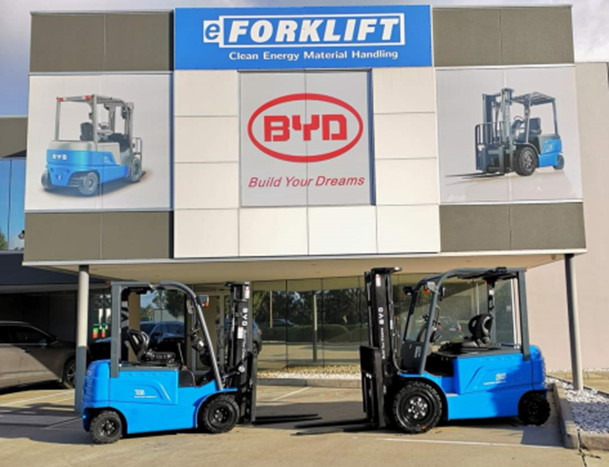- March 8, 2023
- No Comment
BYD Lithium Battery Forklifts vs Gas Forklifts: How Much Could You Save?

Presented by eForklift
In recent years the world has shifted away from traditional fuel sources with many opting to reduce their carbon footprint using sustainable carbon-neutral alternatives. While electric machines are still relatively new to the market, they are making a significant impact thanks to their high efficiency, zero pollution and lower operating costs.
Businesses around Australia are making the shift to electric powered forklifts to improve their bottom line and reduce their carbon footprint but many businesses are still sceptical.
Leading the way in the electric Forklift and Material Handling industry, Melbourne-based eForklift, is a leading supplier of lithium battery powered material handling equipment in Australia, and is the exclusive distributor of BYD forklifts.
Alex Qi, CEO of eForklift, says that while many businesses requiring material handling are slow to move into the electric-powered space, the rise of brands such as Tesla are helping to make electric an accepted concept within the industry.
“One of the main objections to switching to electric-powered forklifts is the lifting and operating capacity, as well as the true cost savings after all is said and done. We find that once our customers can see a real world comparison they’re quicker to accept new technology. This is why we’ve created our interactive comparison calculator.”
Using the eForklift interactive calculator we compared the operating costs of two typical businesses in manufacturing and fabrication to see just how much the average business could save by switching to a lithium battery powered forklift fleet.
Cost Comparison: Mal’s Manufacturing vs Fred’s Fabrication
Take two businesses: Fred’s Fabrication and Mal’s Manufacturing.
Both businesses are nearly identical in their operations and both require a fleet of 18 forklifts. Mal’s Manufacturing uses LPG forklifts, while Fred’s Fabrication has recently turned-over their old forklift fleet and now run lithium powered forklifts. With both companies constantly shifting pallets of stock and fabricated assemblies, their 18 forklifts operate a full 6 hours a day.
Let’s compare the two fleet operating costs below:
Calculation Result
|
Economy in cost of operation |
Cost Comparison |
|
|
Item |
LPG Forklift |
Lithium Battery Forklift |
|
Maintenance Cost Per Year |
$2,340 |
$1,248 |
|
Energy Cost Per Year |
$3,333 |
$991 |
|
Total Cost Per Year |
$5,673 |
$2,239 |
|
Savings per year with BYD Forklift |
$3,434 |
|
How Much Could You Save?
As you can see, Fred’s Fabrication is saving up to $3,434 per year by using a lithium battery forklift. That’s over $17,000 worth of savings in 5 years! These savings come from the minimal maintenance required on lithium battery forklifts.
“On average, a gas forklift can cost about $1.50 an hour of operation on maintenance, while our BYD lithium powered forklifts cost about 80c an hour of operation,” says Mr. Qi.
BYD lithium battery forklifts require minimal maintenance due to the fully packed and sealed battery where damage is unlikely to occur. They can also reach a discharging rate of 98%, which is better than conventional lead-acid batteries which discharge at 60%.
Not only this, but BYD lithium battery forklifts also go through rigorous testing to ensure there is no acid lead or explosive risk to the battery. These batteries are adaptable and can work in conditions from -40 degrees Celsius to 60 degrees Celsius.
Things to Consider
While there are a range of advantages to lithium battery forklifts it’s also important to consider the logistics when making the switch. Just some of the things to consider include:
- Price—while cheaper to operate in the long-run, some electric forklifts come with a high upfront cost.
- Charging & recharging time—BYD forklifts don’t require a full charging room or spare battery, but it’s still important to note how long you’ll need to charge and recharge the machine to reach your desired operational hours.
All in all, it’s clear lithium battery forklifts can save you thousands in running costs over the life of the machine. These machines are highly efficient, and are a great option for those looking to make the switch to zero emission machines.
For more information on lithium battery forklifts, get in touch with eForklift. The team has created a cost comparison calculator to showcase the savings you could make from switching to a battery powered fleet.
Try your own comparison here: https://www.eforklift.com.au/byd-lithium-cost-comparison-calculator/
*Comparison table made using eForklift comparison calculator where all figures are based on industry averages, actual comparisons must be based on onsite usage with recorded numbers. Contact eForklift for more information.




